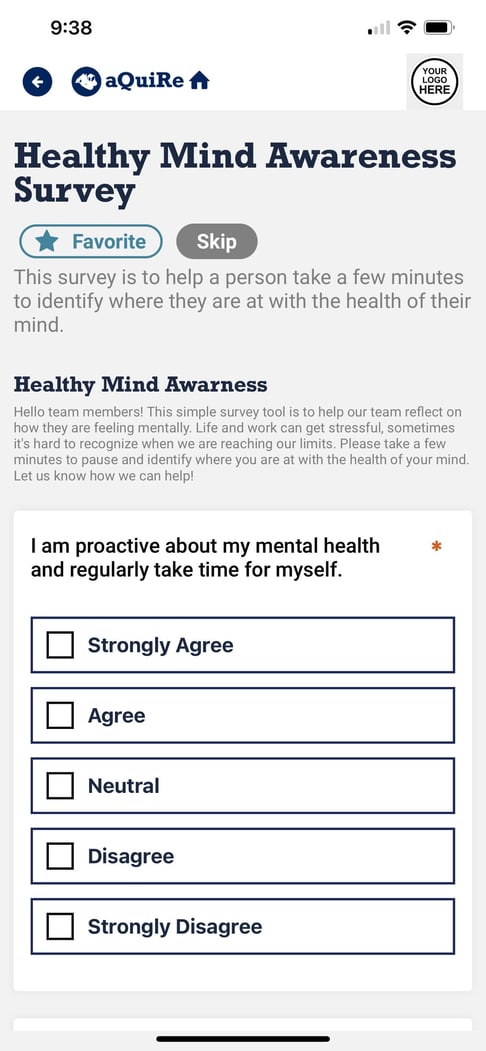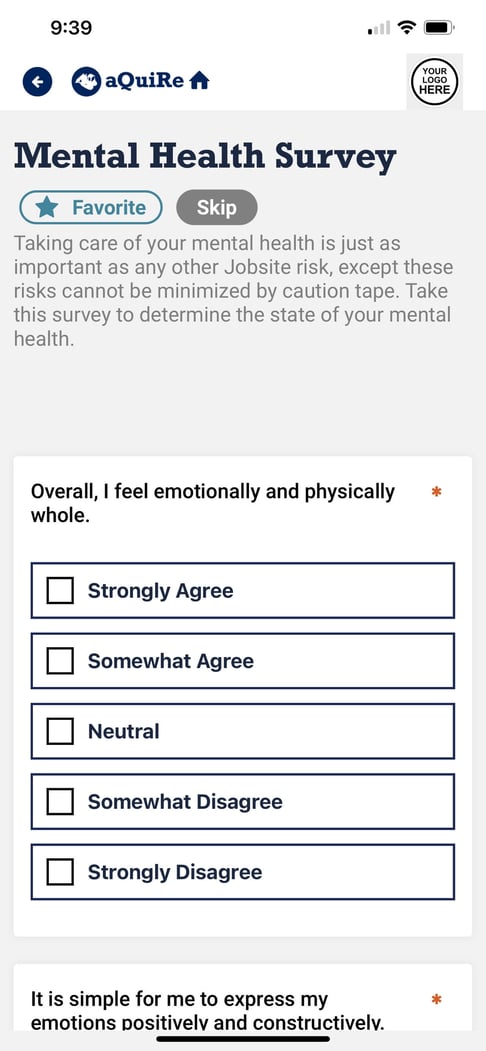
The past few years have been a rollercoaster for everyone dealing with COVID-19, both physically and mentally. The workplace has put some extra stress on employees, with many having to work remotely or in different conditions than what they're used to.
As the workforce industry returns to normal, some people might come back with mental health issues they've been battling for a while. Other employees may feel like they must put on a brave face and act like everything is okay when it's not.
Their coworkers or leadership may not always understand what they're going through, but that doesn't mean they can't try to help. So, the question is: how can you tell if your employees are struggling with poor mental health, and what can you do about it?
As an employer, it's important to be aware of the signs that an employee is struggling and have a plan to address these issues. There are a few ways you can support employee mental health, and in this article, we will cover one of them: conducting a mental health survey.
How can surveys help address employee mental health?
A mental health survey will help companies evaluate how everyone on their team is doing and determine if anything has been affecting their working experience.
A survey may ask general questions about the workplace to get a sense of how employees feel about their job. From there, you can ask more specific mental health survey questions, such as:
- Do you feel like you have the support of your team?
- Do you feel like your workload is manageable?
- Do you feel like your voice is heard?
- Do you feel like you can take breaks when you need to?
- Do you feel like you have the opportunity to advance in your career?
After you've collected the results, you can see which areas need improvement. For example, you can adjust the workload on specific members and even bring some counseling on a daily or weekly basis into the workplace.
Conducting employee mental health surveys can help identify potential risks or problems so you can address them before they cause more damage. They can provide a feeling of trust between employer and employee. Mental health surveys can also be a way for you to offer support and make changes in the workplace that will benefit everyone.
Conducting a survey is a great way to start a conversation about mental and physical health in the workplace. It can show employees that you are invested in their well-being and want to create a workplace where they can thrive.
How can I make mental health awareness a priority?
As the newer generations (like Gen Z) enter the workforce, they are more vocal about wanting their employers to focus on their mental health. Workforce mental health benefits are becoming a more significant focus in the construction industry for a good reason.
60% of Gen Z employees stated they look for mental health support and resources when selecting an employer to work for, and over 70% of full-time workers state they have difficulty accessing counseling services for their needs.
According to McKinsey & Company, about 70% of employers "report they plan to invest in mental health resources by starting, continuing, or expanding benefits in 2021." Roughly the same amount of companies have decided to appoint a mental health leader.
The leader's job is to monitor the overall mental health of employees and any mental health-related workplace programs. These results show us that employers are starting to understand the importance of mental wellness in the workplace and are beginning to take steps to address it.
One of the companies taking the lead in workplace mental health is Google. They've recently launched an effective mental and behavioral health program, with former Headspace executive Megan Jones Bell as an advisor.
Throughout this program, Google has rolled out a series of mental health and well-being screenings for conditions like anxiety and PTSD. They have launched partnerships around substance abuse and have started to address the workplace culture head-on.
Along with their wearables company Fitbit, Google implemented various tools to help people with stress management and clear their thoughts with everyday mindfulness.
The mental health stigma
Often, people don't want to address their mental health issues in the workplace because they fear it will make them look weak. To prioritize mental health awareness, we need to start by destigmatizing it.
What is a mental health stigma?
A stigma is societal disapproval of personal characteristics or beliefs that are different from what is considered the "norm." The mental health stigma can be defined as society's negative attitudes, ideas, and behaviors towards mental illness. For example, people may publicly shame others for having a mental health condition or avoid them altogether.
The mental health stigma can make people feel isolated, ashamed, and unworthy. It can also prevent people from seeking help and getting the treatment they need.
What causes it?
One of the main reasons the mental health stigma exists is because of the way mental illness is portrayed in the media. The media often portrays people with mental illness as dangerous, violent, and unpredictable, which is not only misleading but very harmful.
Another reason the mental health stigma exists is the lack of understanding of mental illness. Many people don't understand what mental illness is and how it can affect others. This lack of knowledge can lead to fear and prejudice.
Mental health stigma usually occurs when people lack education and perspective on people who may suffer from mental health issues and fail to realize how big of an impact they really have on someone's life.
According to the Mental Health Foundation, 9 out of 10 people with mental health conditions feel stigmatized and discriminated against in their lives. Stigmas created by groups within a company can affect someone's ability to do their job and feel comfortable in their workplace.
This is another reason why addressing workplace mental health is so important. By destigmatizing mental illness, we can create a more inclusive and supportive environment for everyone.
Who is most affected by it?
Employee mental health is a pressing matter for anyone in the workforce, especially in the construction industry. And while it can affect anyone, some key demographics face greater risks.
In the construction industry, the most at-risk demographic is boomers (workers born between 1946 and 1964). This is due to various factors, including the fact that they are likely to have worked in the industry for an extended time and thus been exposed to more hazardous conditions.
They are also more likely to have held multiple jobs in the industry, which can lead to job insecurity and a feeling of constantly being on the brink of unemployment. Furthermore, many boomers are reluctant to retire, making them more likely to experience burnout.
Other at-risk groups include:
- Workers with pre-existing mental health conditions: These workers are more likely to experience a deterioration in their mental health due to the stresses of the job.
- Men: Men are more likely to experience mental health challenges due to the traditional masculine norms of stoicism and self-reliance.
- Young adults: Young adults are at risk of experiencing anxiety and depression due to the pressures of starting their careers.
- Immigrants: Immigrants are more likely to experience mental health problems due to the stress of adjusting to a new country and culture.
- LGBTQ+ workers: LGBTQ+ workers are more at risk of experiencing mental health issues due to the stress of discrimination and feeling like they have to hide their identity.
The American Psychological Association reports that throughout their life, 30.6% of men go through a period of depression, and one in every four talks about these feelings to a mental health professional. Boomers (both men and women) also have problems with talking about their feelings and opening up when they have issues with their mental health.
This is partially because men are taught to be stoic and not express emotions. It's also due to the fact that many boomers grew up in a time when mental health was not discussed openly, and people were generally more reluctant to seek help for these sorts of problems.
This reluctance to talk about mental health can be a barrier to seeking treatment and getting the help that people need. It's important to encourage open discussion about mental health in the workplace so that people feel comfortable seeking help when needed.
How can companies address mental health stigma?
Many companies have a problem with mental health stigmas in their workplace, and around "80% of employees report it to be true," says Mckinsey & Company.
There are different approaches to fixing these issues. One is an anti-stigma campaign that 80% of employees state would be effective, but <25% of companies have utilized this tool. Other effective ways to create an inclusive work culture are ensuring workplaces support mental health well-being and training employees to support each other by recognizing signs of distress.
Creating an environment where people feel comfortable talking about their mental health can go a long way in addressing the issue. This can be done by:
- Encouraging people to take breaks and use their vacation days: Overworking employees can lead to burnout, which can trigger mental health problems.
- Promoting a healthy work-life balance: A healthy work-life balance is essential for maintaining mental health.
- Encouraging employees to participate in wellness activities: Wellness activities like yoga, meditation, and exercise can help reduce stress and promote mental health.
- Offering mental health resources: Many companies offer employee assistance programs that provide mental health resources like counseling and therapy.
- Training managers to recognize the signs of mental distress: Managers play a crucial role in supporting employees' mental health. They should be trained to recognize the signs of mental distress and how to respond.
How to use a mental health survey to take action on workplace mental health?
Mental health surveys can be a helpful tool for companies to gauge their employees' mental health and take action to improve workplace mental health.
When designing a mental health survey, it's essential to consider what information you want to collect and how you will use the data. It's also important to ensure the survey is confidential and anonymous to encourage honest responses.

Once you have collected the data from the survey, you can use it to take action to improve workplace mental health. Some steps you can take include:
- Offering more mental health resources: If your survey shows that employees struggle with mental health, you can offer more resources like counseling and therapy.
- Training managers to recognize the signs of mental distress: If your survey shows that employees are struggling with mental health, you can train managers to recognize the signs of mental distress and know how to respond.
- Creating an action plan: Use the data from your survey to create an action plan for improving workplace mental health.
What to put in a mental health survey?
The actual survey that employees will take requires some serious considerations. You need to ensure that nothing is too abrupt and that employees can gradually warm up to the questions.
You also need to consider how much you want to know. If the goal is to get a general idea of how employees feel, then you might want to focus on questions about work-life balance, job satisfaction, and whether employees feel like they can talk to their managers about mental health.
If you want to get more specific, you can ask about mental health diagnoses, whether employees have ever considered suicide, and how often they feel anxious or depressed.
It's important to remember that you can't force employees to answer any questions they don't want to, so make sure all questions are optional.
How to create a mental health survey?
Creating a survey is relatively low cost and will provide much more helpful information in return. Employers may first create a demographic profile of the employee towards the beginning of the survey, collecting general info like the employee's name, age, position, race, education, etc.
Next, the employer may want to focus on more detailed questions about mental health. According to the CDC, these may include "Health status," "Use of preventive health services," and "Health behaviors."
Employers will also want to use validated survey tools and questions. Established surveys like the CDC Behavioral Risk Factor Surveillance Survey (BRFSS) and The National Health and Nutrition Examination Survey (NHANES) contain various questions and topics that can be useful in creating surveys.
When should you send out a mental health survey?
There is no perfect time to send out a mental health survey. Generally, it's best to send out a survey when you can give employees time to fill it out and when you have the resources to take action on the results.
If you're considering a mental health survey, you might want to consider sending it out:
- At the beginning of the year
- After a company-wide event
- Before or after implementing a new policy
- When you're planning to make changes to the workplace
- Whenever you want to check in on employees
By taking the time to design and implement a survey, you can learn about the mental health needs of your employees and take steps to address them. A mental health survey can help you create a healthier and happier workplace for everyone.

What do CAHill health surveys look like?
At CAHill, we offer customized health surveys for construction companies. Our surveys help you identify the health risks specific to your company and our industry. We also provide a variety of ready-made health surveys that can be used to assess the general health of your employees.

Our health surveys cover a wide range of topics, including mental health, substance abuse, musculoskeletal disorders, and more. CAHill also offers various other services, like on-site training, standards logging, and more, to help create a safe and healthy workplace.
Contact us today if you're interested in learning more about what we do. We'll be happy to answer any of your questions. And if you want a customized healthy survey built for your team, do not hesitate to reach us at info@cahillresources.com. We will send you one for free!



